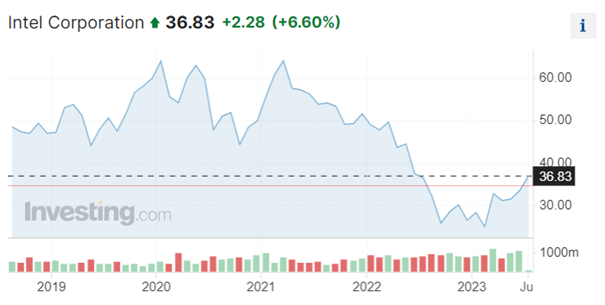With that in mind, I was scrolling Reuters today and found one very heartwarming news – Intel’s positive results boosted chip stocks. The article said that Intel's shares experienced a more than 4% increase on Friday following the chipmaker's unexpectedly strong quarterly report, signalling a potential turnaround in its fortunes after struggling with declining PC sales and fierce competition in the data centre market, which impacted its margins for a long time.* The company's surprise second-quarter profit and optimistic earnings and margin forecasts indicate that the slump in the personal computer market might be coming to an end, leading to the surge in its stock price and the broader chip sector.[1] As a result, Intel's market value is expected to rise by about 6 billion USD, already surpassing Wall Street's median target of 35 USD, with numerous brokerages raising their price targets on the stock.[2] Analysts believe that Intel's turnaround is finally happening, and this positive momentum could lead to better quarters ahead for the company and other chipmakers. However, it is worth noting that Intel has faced strong competition from rivals like TSMC and Nvidia, impacting its margins and market value compared to its counterparts in the industry.
Very amazing news for Intel. However, it is true that Nvidia is a very big competitor and will take a lot of work to overtake them. Not only that Nvidia is the biggest player in gaming sector (they make the most money out of it), but they also got popular with the mining of Bitcoin, because of their performance. But about that another time. I have been reading about shortage of chips in the industry for a long time. Also, in the car sector. But it seems it could all turn around.
As for the technical analysis, there is not much to think about it. Stocks suffered correction, but as mentioned in the article, it seems they are back on track. Current price is 36,83 USD for a stock, and I hope that is also the price at which I will be able to enter the market, as soon as it opens. *

Movement of Intel stocks in the last five years. (Source: Investing) *
* Past performance is no guarantee of future results.
[1,2] Forward-looking statements are based on assumptions and current expectations, which may be inaccurate, or based on the current economic environment which is subject to change. Such statements are not guaranteeing of future performance. They involve risks and other uncertainties which are difficult to predict. Results could differ materially from those expressed or implied in any forward-looking statements.








